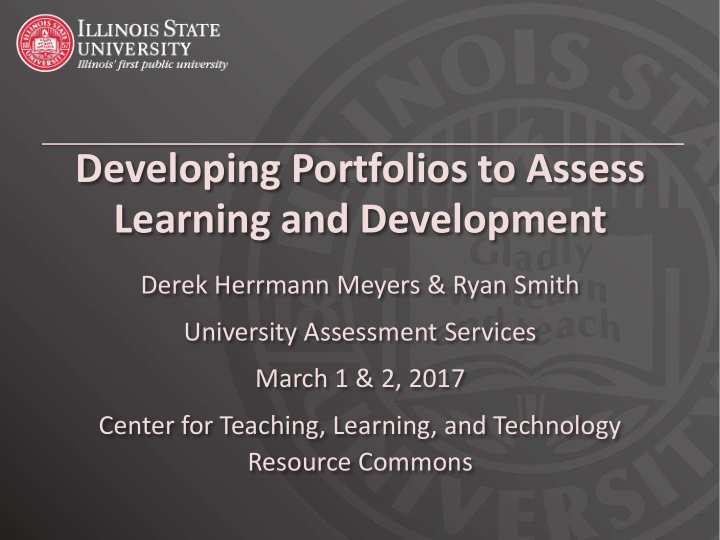



Developing Portfolios to Assess Learning and Development Derek Herrmann Meyers & Ryan Smith University Assessment Services March 1 & 2, 2017 Center for Teaching, Learning, and Technology Resource Commons
Opening questions • What experiences have you had with portfolios… – As a student? – As a faculty/staff member? • If you have had experience, what are your thoughts on portfolios?
Purposes of portfolios • Documentation of student progress: Provide evidence of students’ growth • Showcase student accomplishments: Include students’ ‘best work’ and thoughtful reflections on those • Evaluation of student status: determine whether students have met previously-set quality levels
Folders v. portfolios Folders Portfolios Serve as repositories for student work Have clear educational purposes and help students learn Contents are specified by instructor and Students choose what goes in using include everything completed in a class criteria provided by instructor May not be evaluated systematically Assessed using criteria developed by instructor (often with rubric) Composed only of final products Can illustrate growth Do not represent a substantive learning Include written reflections on significance opportunity and contribution of each item
Why use portfolios? • Compelling evidence of what a student has learned – Assemble many different kinds of evidence for learning and skills in one place – Encourage students, faculty, and staff to examine learning holistically – Show outcomes AND growth as a learner
Why use portfolios? • Valuable to students, faculty, and staff – Encourage students to be involved in their learning by reflecting and selecting documentation (develops synthesis and metacognitive skills) – Encourage diversity in learning activities – Provide fodder for richer conversations – Show what AND how students learned
Considering a portfolio? • What are the goals? • Who are the portfolio’s audiences? • How and when will students choose what to include? • How will student and faculty/staff reflection be ensured?
Considering a portfolio? • How will the portfolios be evaluated? • Who will review and evaluate the portfolios? • How will the collection and evaluation processes be kept manageable? • Who ‘owns’ the portfolio?
What can go into a portfolio? • Table of contents • Examples of student work
Examples of student work • Papers and other assignments • Peer assessments • Attitude and interest surveys • Tests or logs of test scores • Statements of students’ goals for learning and development • Notes from faculty, staff, and supervisors • Supervisors’ evaluations
What can go into a portfolio? • Evidence of learning processes, growth, and improvement, such as: – Worked completed earlier in a program – Drafts – Work logs • Introductory statement (written by students) to help evaluators better understand it
What can go into a portfolio? • Reflection page – students reflect on overall contents of completed portfolio
Overall questions on which students can reflect • Which item is my best/most important/most or least satisfying work? Why? • With which item did I stretch yourself the most, taking the greatest risk in what you tried to do? • What are three things I learned by completing this portfolio? • What does this portfolio say about me as an emerging professional/scholar? • What are my goals for continuing to learn, grow, and develop?
What can go into a portfolio? • Reflection page – students reflect on overall contents of completed portfolio • Reflections on each item in the portfolio
Item-specific questions on which students can reflect • What learning goal(s) did this item address? • Why did I choose this item for your portfolio? • What does this item show about me as a professional/scholar? • What did I learn by completing this item? • What questions about this item do I have?
Information for students • Faculty/staff goals for the portfolios (what students will learn by compiling them) • Items to be included (both faculty/staff- determined and student-selected) • When items should be added • By when portfolios should be completed • How and when portfolios will be evaluated
Evaluating portfolios • Purpose/intent should determine • Assessing student progress in goal achievement: Rubric that includes goals as criteria • Encouraging performance improvement: In terms of progress from drafts and early work to final products and later work • Encouraging metacognition: In terms of effort put into self-reflection
Keeping things manageable • Limit the number of items in each portfolio • Keep portfolio items short or include excerpts from longer products • Start small and gradually increase number of items • Ask faculty/staff to include any completed rubrics they may have used • Consider sampling of portfolios for review
Recommend
More recommend